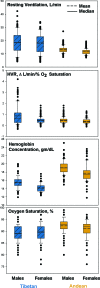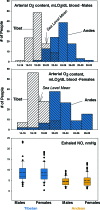Two routes to functional adaptation: Tibetan and Andean high-altitude natives
- PMID: 17494744
- PMCID: PMC1876443
- DOI: 10.1073/pnas.0701985104
Two routes to functional adaptation: Tibetan and Andean high-altitude natives
Abstract
Populations native to the Tibetan and Andean Plateaus are descended from colonizers who arrived perhaps 25,000 and 11,000 years ago, respectively. Both have been exposed to the opportunity for natural selection for traits that offset the unavoidable environmental stress of severe lifelong high-altitude hypoxia. This paper presents evidence that Tibetan and Andean high-altitude natives have adapted differently, as indicated by large quantitative differences in numerous physiological traits comprising the oxygen delivery process. These findings suggest the hypothesis that evolutionary processes have tinkered differently on the two founding populations and their descendents, with the result that the two followed different routes to the same functional outcome of successful oxygen delivery, long-term persistence and high function. Assessed on the basis of basal and maximal oxygen consumption, both populations avail themselves of essentially the full range of oxygen-using metabolism as populations at sea level, in contrast with the curtailed range available to visitors at high altitudes. Efforts to identify the genetic bases of these traits have included quantitative genetics, genetic admixture, and candidate gene approaches. These reveal generally more genetic variance in the Tibetan population and more potential for natural selection. There is evidence that natural selection is ongoing in the Tibetan population, where women estimated to have genotypes for high oxygen saturation of hemoglobin (and less physiological stress) have higher offspring survival. Identifying the genetic bases of these traits is crucial to discovering the steps along the Tibetan and Andean routes to functional adaptation.
Conflict of interest statement
The author declares no conflict of interest.
Figures





References
-
- Trinkaus E. Annu Rev Anthropol. 2005;34:207–240.
-
- Aldenderfer MS. Am Sci. 2003;91:542–549.
-
- Ward MP, Milledge JS, West JB. High Altitude Medicine and Physiology. London: Oxford Univ Press; 2000.
-
- Raymond J, Segre D. Science. 2006;311:1764–1767. - PubMed
-
- Hochachka P, Rupert J. BioEssays. 2003;25:515–519. - PubMed
Publication types
MeSH terms
Substances
Grants and funding
LinkOut - more resources
Full Text Sources

